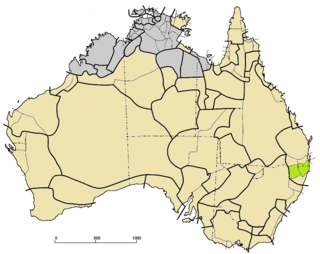Murri is a demonym for Aboriginal Australians of modern-day Queensland and north-western New South Wales. For some people and organisations, the use of Indigenous language regional terms is an expression of pride in their heritage. The term includes many ethno-linguistic groups within the area, such as the Kamilaroi (Gamilaraay) and Yuggera (Jagera) peoples.

The Kabi Kabi people, also spelt Gubbi Gubbi, Gabi Gabi, and other variants, are an Aboriginal Australian people native to South Eastern Queensland. During the Australian frontier wars of the 19th century, there were several mass killings of Kabi Kabi people by settlers. They are now classified as one of several Murri language groups in Queensland. A 2024 determination granted non-exclusive native title rights over an 365,345-hectare (902,790-acre) area of land and waters on the Sunshine Coast.

Yugambeh, also known as Tweed-Albert Bandjalang, is an Australian Aboriginal language spoken by the Yugambeh living in South-East Queensland between and within the Logan River basin and the Tweed River basin, bounded to the east by the Pacific Ocean and in the west by the Teviot Ranges and Teviot Brook basin.
Kalkatungu is an extinct Australian Aboriginal language formerly spoken around the area of Mount Isa and Cloncurry, Queensland.

Yugambeh–Bundjalung, also known as Bandjalangic, is a branch of the Pama–Nyungan language family, that is spoken in north-eastern New South Wales and South-East Queensland.
The Gidabal, also known as Kitabal and Githabul, are an indigenous Australian tribe of southern Queensland, who inhabited an area in south-east Queensland and north-east New South Wales, now within the Southern Downs, Tenterfield and Kyogle Local Government regions.
The Turrbal are an Aboriginal Australian people from the area now known as Brisbane. The boundaries of their traditional territory are unclear and linguists are divided over whether they spoke a separate language or a dialect of the Yuggera language. The Turrbal/Yuggera toponym for the central Brisbane area is Meanjin.

The Bundjalung people, also spelled Bunjalung, Badjalang and Bandjalang, are Aboriginal Australians who are the original custodians of a region from around Grafton in northern coastal New South Wales to Beaudesert in south-east Queensland. The region is located approximately 550 kilometres (340 mi) northeast of Sydney and 100 kilometres (62 mi) south of Brisbane that now includes the Bundjalung National Park.

The Jagera people, also written Yagarr, Yaggera, Yuggera, and other variants, are the Australian First Nations people who speak the Yuggera language. The Yuggera language which encompasses a number of dialects was spoken by the traditional owners of the territories from Moreton Bay to the base of the Toowoomba ranges including the city of Brisbane. There is debate over whether the Turrbal people of the Brisbane area should be considered a subgroup of the Jagera or a separate people.
Turrbal is an Aboriginal Australian language of the Turrbal people of the Brisbane area of Queensland.

The Yugambeh, also known as the Minyangbal, or Nganduwal, are an Aboriginal Australian people of South East Queensland and the Northern Rivers of New South Wales, their territory lies between the Logan and Tweed rivers. A term for an Aboriginal of the Yugambeh tribe is Mibunn, which is derived from the word for the wedge-tailed eagle. Historically, some anthropologists have erroneously referred to them as the Chepara, the term for a first-degree initiate. Archaeological evidence indicates Aboriginal people have occupied the area for tens of thousands of years. By the time European colonisation began, the Yugambeh had a complex network of groups, and kinship. The Yugambeh territory is subdivided among clan groups with each occupying a designated locality, each clan having certain rights and responsibilities in relation to their respective areas.
The Kombumerri clan are one of nine distinct named clan estate groups of the Yugambeh people and the name refers to the Indigenous people of the Nerang area on the Gold Coast, Queensland. Australia
The Dalla, also known as Jinibara, are an indigenous Australian people of southern Queensland whose tribal lands lay close to Brisbane.
The Undanbi are an Aboriginal Australian people of southern Queensland. Alternative or clan names include Inabara, Djindubari and Ningy Ningy.
The Geynyon, also written Keinjan, are an indigenous Australian people of southern Queensland. According to research done by Queensland South Native Title Services (QSNTS) entitled South East Regional Research Project (SERRP) 'Geynyan' are in all likelihood an dialect/estate group of the wider Githabul peoples. In May 2021 the Githabul peoples lodged a Native Title claim over much of the former Warwick Shire within the Southern Downs Regional Council area.
The Galali or Kalali were an indigenous Australian people of the state of Queensland.
The Yalarnnga, also known as the Jalanga, are an Indigenous Australian people of the state of Queensland.
Margaret Clare Sharpe is a linguist of Australian Aboriginal languages, specializing in Yugambeh-Bundjalung languages, with particular regard to Yugambir, She has also done important salvage fieldwork on the Northern Territory Alawa language.

Monarch Glen is a rural locality in the City of Logan, Queensland, Australia. It is situated along the development corridor south of Brisbane in the Greater Flagstone development area and is one of four new suburbs that have been created in Logan to house a predicted population boom between Brisbane and the Gold Coast. In the 2021 census, Monarch Glen had "no people or a very low population".
Silverbark Ridge is a rural locality in the City of Logan, Queensland, Australia. It is situated along the development corridor south of Brisbane in the Greater Flagstone development area and is one of four new suburbs in Logan to house a predicted population boom between Brisbane and the Gold Coast. In the 2021 census, Silverbark Ridge had "no people or a very low population".







